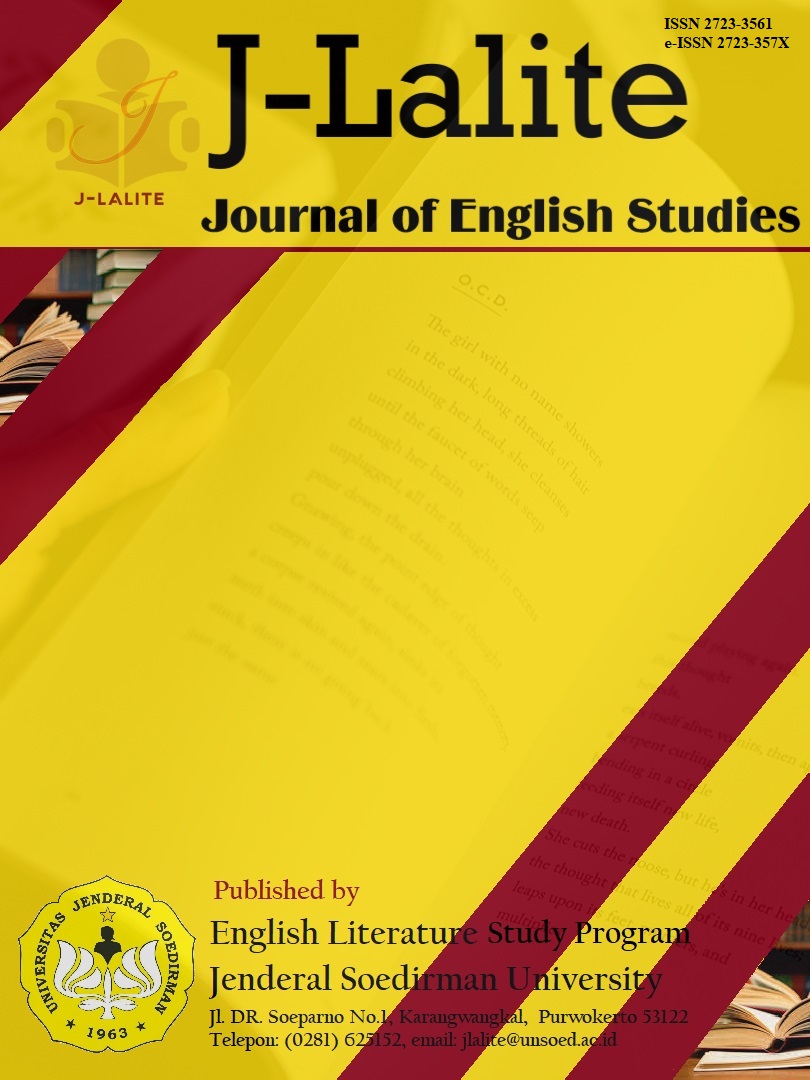Wordplay “Loss” in Translation:
A Case Study of Margaret Atwood’s The Handmaid’s Tale
Abstract
Wordplay can be described as the way of making or using words to create additional meaning for some purposes. Using a qualitative approach, this study discusses the wordplay translation in literary work especially in dystopian fiction using Delabastita’s translation techniques of wordplay. The data derived from a novel entitled The Handmaid’s Tale by Margaret Atwood as the source text and its subsequent translation in Bahasa Indonesia entitled The Handmaid’s Tale – Kisah Sang Handmaid as the target text. From 50 data retrieved, the result shows that the most frequently applied technique in wordplay translation is Wordplay to Non-Wordplay that appears 25 times or 50%. The result of this study illustrates that the translation of wordplay in this literary work tends not to preserve the author’s style of writing but one of the author’s intended meanings.
References
Alikhonovna, Y. M., Abdurashidovna, S. S., & Makhsudovna, M. S. (2021). Alikhonovna, Yusupova Munira; AbdurashidoLiterary Translation Problems and Features of The Literary Text, 326-348.
Antaniami, A. (2018). A Study of Wordplay Translation In Lewis Carroll's Alice's Adventures In Wonderland. Surabaya: Universitas Airlangga.
Atwood, M. (1998). The Handmaid's Tale. New York: Anchor Books.
Bahaa-eddin, & Hassan, A. (2011). Literary Translation: Aspects of Pragmatic Meaning. Cambridge: Cambridge Scholars Publishing.
Bazzurro, L. C. (2015). Some Thoughts on Literary Translation. Translation Journal.
Charina, I. N. (2017). Lexical and Syntactic Ambiguity in Humor. International Journal of Humanity Studies, 120-131.
Comrie, B. (2009). The World's Major Languages. Oxon: Routledge.
Culpeper, J., Kerswill, P., Wodak, R., McEnery, T., Katamba, & Francis. (2018). English Language: Description, Variation and Context. London: Palgrave.
Delabastita, D. (1996). Introduction to Translation. The Translator, 2(2), 127-139.
Delzendehrooy, M., & Karimnia, A. (2013). A Comparative Study of Modulation in English Translations of Khayyam's Quatrains. Provedia - Social and Behavioral Sciences, 28-40.
Gold, E. (2002). English Shmenglish: Yiddish Borrowings into Canadian English. Proceedings of the 2002 annual conference of the Canadian Linguistic Association, 108-120. Ottawa: Canadian Linguistic Association.
Hartono, R. (2018). Novel Translation (Tripartite Cycle Model-Based Approach). Semarang: UNNES Press.
Hernández-Santaolalla, V., & Barrientos-Bueno, M. (2020). Handbook of Research on Transmedia Storytelling, Audience Engagement, and Business Strategies. Seville: IGI Global.
Irawan, S. (2018). The Handmaid's Tale - Kisah Sang Handmaid. Jakarta: Gramedia Pustaka Utama.
Lalić-Krstin, G. (2018). Translating English Wordplay into Serbian: Evidence from Three Dystopian Novels. Belgrade English Language and Literature Studies, 327-348).
Landers, C. E. (2001). Literary Translation: A Practical Guide. Clevedon: Multilingual Matters Ltd.
Leech, G. (1969). A Linguistic Guide to English Poetry. London: Longman Publisher.
Lefevere, A. (2003). Introduction. in A. Lefevere (ed) Translation/History/Culture, 1-13. London & New York: Routledge.
Lefevere, A., & Bassnett, S. (1998). Introduction: Where are we in Translation Studies? in A. Lefevere, & S. Bassnett, Constructing Cultures: Essays on Literary Translation, 1-11. Clevedon: Multilingual Matters Ltd.
Lexico. (2021, May). retrieved from Lexico.com: https://www.lexico.com/
Loudermilk, K. A. (2003). Fictional Feminism: How American Bestsellers Affect the Movement for Women's Equality. New York & London: Routledge.
merriam-webster. (2021, May). retrieved from merriam-webster dictionary: https://www.merriam-webster.com/
Parlette, D. (2008). The Penguin Book of Card Games. London: Penguin Books.
Pelliccio, J. (n.d, n.d n.d). Writers House: Department of English. retrieved in September 29, 2019, dari Rutgers School of Arts and Sciences: https://wh.rutgers.edu/creativecwriting/student-writing/353-jacqueline-pelliccio-language-of-oppression-in-the-handmaid-s-tale
Setyaningsih, R. W., & Antamiani, A. (2018). Wordplay or Not Wordplay (The Indonesian version of Lewis Carroll’s Alice’s Adventures in Wonderland). Proceedings of the Second Conference on Language, Literature, Education, and Culture (ICOLLITE 2018), 53-56. Atlantis Press.
Sneddon, J. N., Adelaar, A., Djenar, D. N., & Ewing, M. C. (2010). Indonesian Reference Grammar. Melbourne: Allen & Unwin.
Subiyanto, A. (2018). Revisiting Full Reduplication in Indonesian, Javanese, and Sundanese Verbs: a Distributed Reduplication Approach. Culturalistics: Journal of Cultural, Literary, and Linguistic Studies, 33-41.
Syarifuddin, S. (2017). Assonance in Shakespeare's Poem 'The Rape of the Lucrece'. International Journal of English Research, 84-86.
Vanderstoep, S. W., & Johnston, D. D. (2009). Research Methods for Everyday Life: Blending Qualitative and Quantitative Approaches. San Francisco: Jossey-Bass.
By submitting the manuscript, the author(s) agreed to these following terms:
(1) The copyright of received articles shall be assigned to J-Lalite: Journal of English Studies as the publisher of the journal. The intended copyright includes the right to publish articles in various forms (including reprint). J-Lalite: Journal of English Studies maintain the publishing rights to the published articles.
(2) Author(s) are permitted to disseminate published articles by sharing the link/DOI of the article at J-Lalite: Journal of English Studies. Author(s) are allowed to use their articles for any legal purposes deemed necessary without written permission from J-Lalite: Journal of English Studies with an acknowledgement of initial publication to this journal.
(3) Authors should sign a copyright transfer agreement when they have approved the final proofs sent by J-Lalite: Journal of English Studies prior to the publication.
(4) User/public use of this website will be licensed to Creative Commons Attribution-ShareALike 4.0 International (CC BY-SA 4.0) License.







.png)
.png)
.png)
.png)




